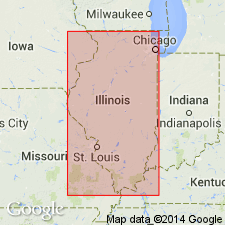
- Usage in publication:
-
- Starved Rock Sandstone Member
- Modifications:
-
- Original reference
- Dominant lithology:
-
- Sandstone
- AAPG geologic province:
-
- Wisconsin arch
- Ozark uplift
Summary:
Pg. 13, 36, 46-47, 225. Starved Rock Sandstone Member of St. Peter Sandstone. Present in Illinois, Iowa, and Missouri. Consists of sandstone that closely resembles underlying sandstone in Tonti Member (new), but is consistently coarser grained. In western Illinois and around margins of formation in north-central and northeastern Illinois the sandstone is partly silty, locally fine-grained, and contains tongues of Glenwood sandstones, but maintains its character as a coarse-grained unit. Thickness normally 60 to 90 feet; 235 feet in well near Joliet. Between McDonough and Scott Counties, western Illinois, and in southeastern Missouri the Starved Rock Sandstone rests on Tonti Sandstone with sharp contact. North of McDonough County the Starved Rock conformably overlies Kingdom Sandstone; grades northward into Glenwood Formation and tongues of Starved Rock-type sandstone are present locally in Loughridge Member (new) of Glenwood and more rarely on top of Harmony Hill Member; grades southward into Joachim and Dutchtown Formations. Age is Middle Ordovician (Champlainian).
Type section: exposures at Starved Rock, French Canyon, and Lovers' Leap, in W/2 NW/4 and NW/4 NW/4 SW/4 sec. 22, T. 33 N., R. 2 E., Ottawa quadrangle, Starved Rock State Park, LaSalle Co., IL.
Source: US geologic names lexicon (USGS Bull. 1350, p. 721).
For more information, please contact Nancy Stamm, Geologic Names Committee Secretary.
Asterisk (*) indicates published by U.S. Geological Survey authors.
"No current usage" (†) implies that a name has been abandoned or has fallen into disuse. Former usage and, if known, replacement name given in parentheses ( ).
Slash (/) indicates name conflicts with nomenclatural guidelines (CSN, 1933; ACSN, 1961, 1970; NACSN, 1983, 2005, 2021). May be explained within brackets ([ ]).

